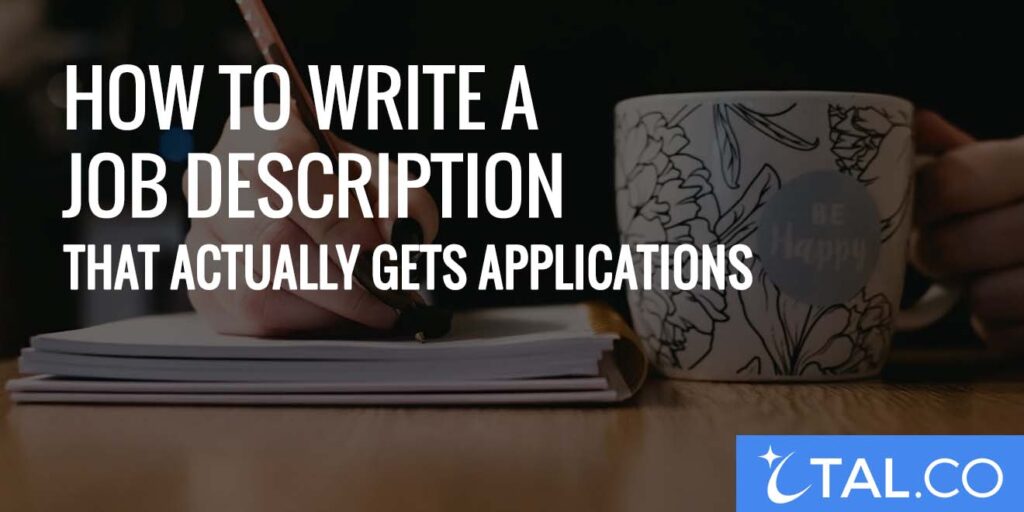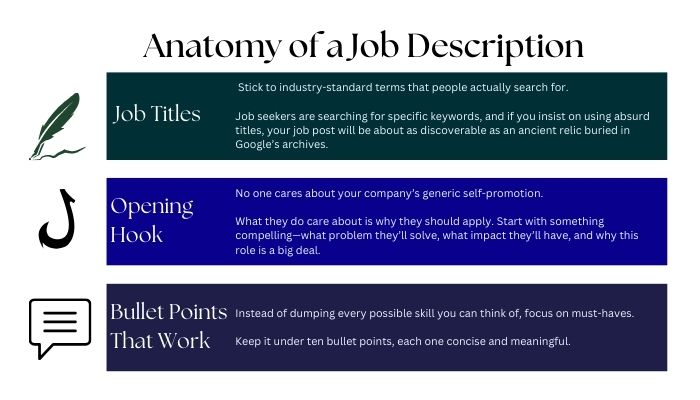
How To Write a Job Description That Actually Gets Applications
You’d think writing a job description that attracts qualified applicants would be a straightforward task. But judging by the current state of job postings, it’s clear that many hiring managers treat it as an afterthought. They slap together a Frankenstein’s monster of vague corporate jargon, sprinkle in a few impossible requirements, and then wonder why their inbox is either flooded with under qualified applicants or gathering dust like an abandoned MySpace page.
If you’re tired of spending months on a hiring process that yields nothing but regret, it’s time to fix your job descriptions. Here’s how to craft one that doesn’t send good candidates running for the hills.
Outline
The Anatomy of a Job Description That Doesn’t Suck

A job description isn’t a legal document or a chance to show off your company’s commitment to “cross-functional synergies.” It’s a pitch—your first and possibly only chance to convince high-caliber candidates that your role is worth their time. If your description reads like a robotic blend of corporate fluff and unrealistic demands, you’re setting yourself up for failure.
Job Titles: Stop Being Cute
“Rockstar Developer,” “Marketing Ninja,” and “Sales Guru” sound quirky—until you realize they’re actively driving away candidates who don’t want to be treated like unpaid interns in a startup cult. Job seekers are searching for specific keywords, and if you insist on using absurd titles, your job post will be about as discoverable as an ancient relic buried in Google’s archives. Stick to industry-standard terms that people actually search for.
The Opening Hook: Make It Less Miserable
If your job description starts with “We are a fast-growing, innovative company looking for a motivated self-starter,” congratulations, you’ve just bored your audience into clicking away. No one cares about your company’s generic self-promotion. What they do care about is why they should apply. Start with something compelling—what problem they’ll solve, what impact they’ll have, and why this role is a big deal. If you can’t capture their interest in two sentences, you’ve lost them.
Bullet Points That Work (And Don’t Make Eyes Bleed)
No one enjoys reading an endless grocery list of requirements, especially when half of them contradict each other. Instead of dumping every possible skill you can think of, focus on must-haves. Keep it under ten bullet points, each one concise and meaningful. And for the love of hiring sanity, stop listing “Proficiency in Microsoft Office” unless you’re hiring for a position that specifically requires a deep understanding of Excel wizardry.
Requirements vs. “Wish Lists”: Your Unicorn Hunt Is Why No One Applies
There’s a fine line between setting reasonable expectations and describing an imaginary candidate who exists only in your dreams. Too many companies treat job descriptions as aspirational documents rather than realistic hiring guidelines.
Minimum Qualifications vs. Nice-to-Haves
If your requirements list asks for 10+ years of experience in a technology that’s only been around for five, you’re not looking for a candidate—you’re looking for a time traveler. Stop treating every possible skill as a dealbreaker. If someone meets 70-80% of your qualifications and has the ability to learn, they’re worth considering. The best hires are adaptable, not pre-packaged.
The GPA Obsession Needs to Die
Unless you’re hiring for a fresh-out-of-college intern, stop obsessing over GPAs. No one’s asking their 40-year-old senior software engineer what they got in Calculus II. Instead, focus on actual experience, problem-solving ability, and results. The best candidates may not have graduated with honors, but they can actually do the job—which is what matters.
Salary Transparency: Stop Playing Hard to Get
One of the fastest ways to turn off a qualified candidate is by keeping salary information a mystery. Companies love to claim they offer “competitive salaries,” yet conveniently leave out any actual numbers.
“Competitive Salary” Means Absolutely Nothing
If your idea of “competitive” is based on 2015 salary trends, expect candidates to laugh and move on. In a world where job seekers can compare salaries with a quick Google search, playing coy won’t do you any favors. Just post the damn range. You wouldn’t buy a car without knowing the price—why expect candidates to apply blindly?
Benefits That Aren’t Just a Sad List of Buzzwords
If your benefits section is just a copy-paste of “great company culture” and “opportunities for growth,” you’re not fooling anyone. Candidates want to know specifics. Is your PTO actually unlimited, or is it a trap where no one actually takes vacation? Does your “flexible work environment” mean remote options, or does it just mean “we won’t yell at you for coming in at 9:05”? Be real. Clarity wins.
How To Make Your Job Posting Actually Findable
A well-written job description doesn’t matter if no one sees it. Just like marketing a product, you need visibility—and that means optimizing for searchability.
Keywords, But Not in a Cringe Way
If your post is drowning in corporate jargon like “synergy-driven thought leadership” and “leveraging holistic strategies,” congratulations—you’ve just confused everyone. Use real terms that people actually type into job boards. Think about how your ideal candidate would search for this job, then make sure your title, responsibilities, and skills reflect those terms.
The Case for Formatting Like a Human Wrote It
Ever read a job description that looks like a poorly formatted legal contract? The walls of text, the tiny font, the aggressive bolding of every other word—it’s a crime against readability. Good formatting is a competitive advantage. Use white space, short paragraphs, and headers that make it easy to scan. Candidates aren’t reading your post for fun; they want to get the information they need, fast.
Make It Less Awful
Even if your job description is perfect, a weak or tedious application process will sabotage your efforts.
The Application Process Shouldn’t Feel Like a Bureaucratic Nightmare
If your process involves uploading a resume and manually re-entering every detail into a 15-page form, you’ve already lost. Candidates have options, and they’re not going to waste time on a system that feels like a tax audit. Streamline it. If you wouldn’t go through your own application process, why expect others to?
Follow Up or Be Forgotten
A candidate applies, and then… silence. If you ignore applicants, they will return the favor when you finally get around to emailing them six weeks later. Automate responses, set realistic timelines, and communicate like a human. The hiring process should be a two-way street, not an ego trip.
Your Job Description Is Your First Impression—Don’t Make It a Bad One
At the end of the day, the best job descriptions are clear, compelling, and honest. If you treat them as throwaway tasks, expect to waste months sorting through a pile of mismatched applicants. Candidates aren’t desperate. They’re discerning. And if your job post doesn’t respect their time, they’ll move on to one that does. Write better job descriptions. Get better applicants. It’s that simple.

